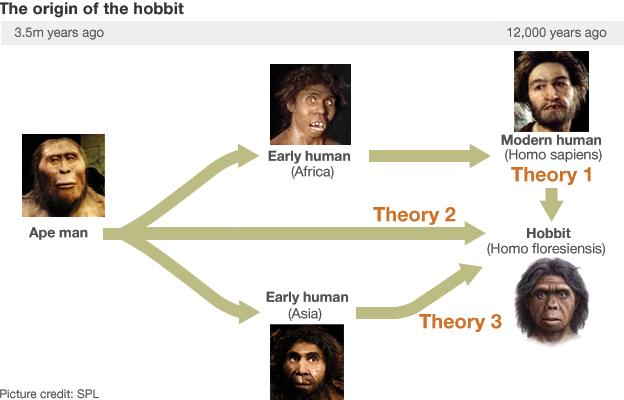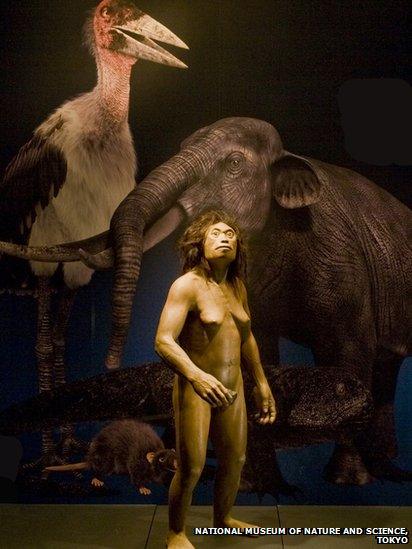Study backs 'hobbit' island dwarfism theory
- Published
How an ancient human species may have shrunk as a result of island dwarfism
A diminutive species of human whose remains were found on the Indonesian island of Flores could have shrunk as a result of island dwarfism as it adapted to its environment.
A study of the remains of the creature, nicknamed the "hobbit", shows that it is possible for it to have been a dwarf version of an early human species.
The hobbit co-existed with our species until 12,000 years ago.
The research has been published in the Royal Society's Proceedings B Journa, externall.
Since its discovery in 2003, researchers have struggled to explain the origins of these metre-high, tiny-brained people, known scientifically as Homo floresiensis.

One popular theory is that the hobbit evolved from a relatively large brained and large bodied human that was prevalent in east Asia, known as Homo erectus. The theory is that after H. erectus moved to Flores, it began to shrink in size over the generations by a process known as island dwarfism, which has been seen to occur in other species.
Critics though argue that it would be impossible for erectus's brain to shrink so much in relation to its body.
Alternative theories are that these creatures are either a small group of modern humans, Homo sapiens, whose brains and bodies have been prevented from growing normally because of a wasting disease, or that they are descendants of tiny-brained ape-like creatures.
New scans by a Japanese team which includes Dr Yousuke Kaifu of the National Museum of Nature and Science, Tokyo, shows that the hobbit's brain was a little larger than previous estimates had suggested.
Small brain
Moreover, Dr Kaifu and his colleagues have also carried out a comparative analysis of the ratio of brain to body size of present-day humans which they say indicates that it is indeed possible for erectus's brain to have shrunk to the size of the hobbit's.
"Our work does not prove that erectus is the ancestor of floresiensis," Dr Kaifu told BBC News. "But what we have shown is that it is possible (and counters the argument) by many people that floresiensis's brain is too small to (be consistent with the view that it is a dwarf form of erectus)"

The hobbit: Could island life have shrunk this creature to diminutive proportions?
Dr Kaifu's analysis backs an earlier study of the hobbit's brain cases by Prof Dean Falk of Florida State University in 2005 and 2007. She concluded that the hobbit was a separate human species. She told BBC News that she believed that the Japanese researchers have "nailed it".
"The authors make a compelling case that H. floresiensis could be descended from an early Homo erectus population," she said. "With all the hoopla surrounding floresiensis, this rigorous analysis is most welcome."
Prof Falk said that she did not believe that the Japanese analysis excluded the alternative hypothesis of an as-yet-undiscovered small-brained ape-like ancestor that migrated from Africa. That was a view echoed by Professor Chris Stringer of the Natural History Museum in London.
"Personally I don't think it solves the problem," he told BBC News. "There are primitive features in the skeleton of floresiensis which for me suggests that it comes from quite a primitive form of human: one that may have been around two million years ago rather than one million years ago".
Twists and turns
Professor Stringer said that the debate over floresiensis is part of a much wider discussion among scientists in the field which is resulting in a new and exciting retelling of the story of how humans emerged.
"It is a fascinating find because it shows that human evolution took a number of twists and turns. It isn't just about the evolution of us modern humans, but actually there are lots of other species around".
"Floresiensis was a failed experiment that lasted to within the last 50,000 years or so and we are the last survivors of all these other experiments in evolving humans".
Follow Pallab on Twitter, external
- Published17 April 2013